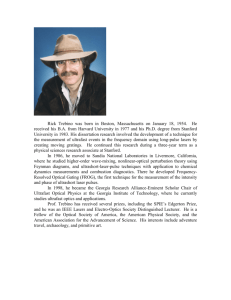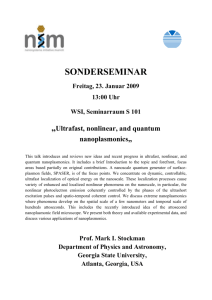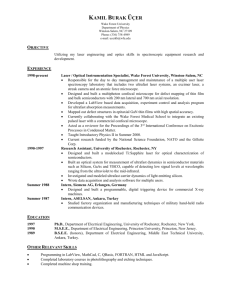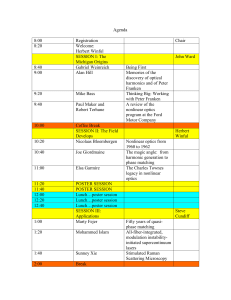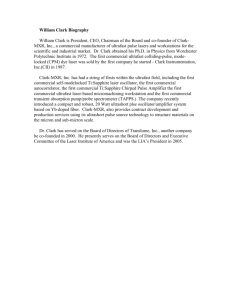Phys 577: Ultrafast and Nonlinear Optics
advertisement
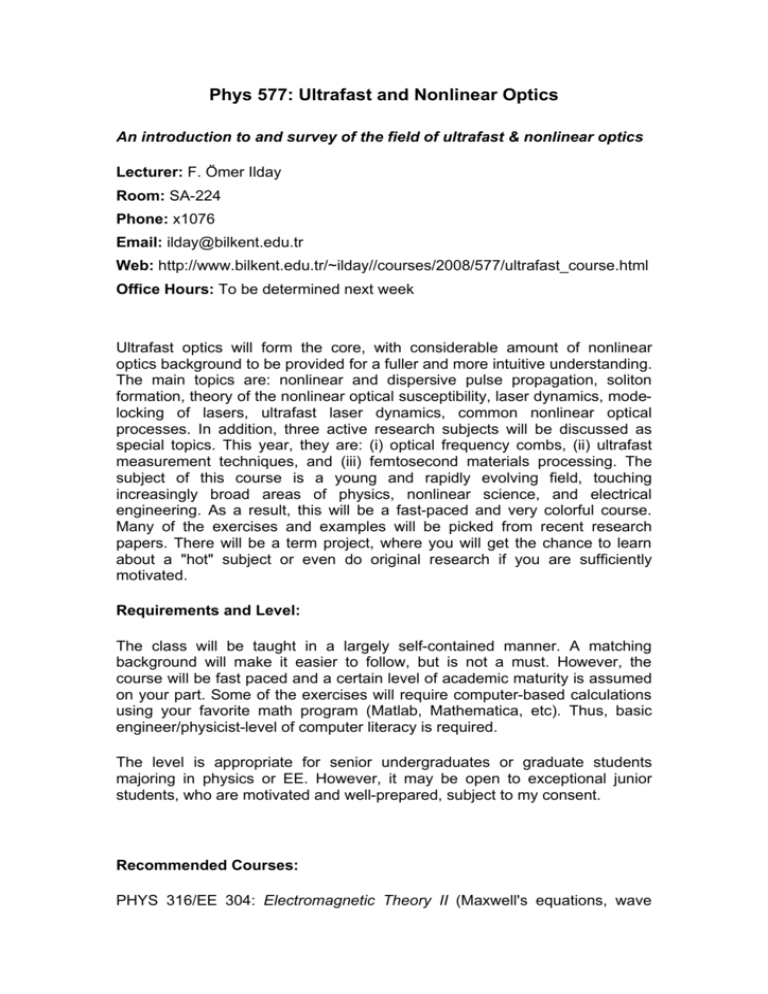
Phys 577: Ultrafast and Nonlinear Optics An introduction to and survey of the field of ultrafast & nonlinear optics Lecturer: F. Ömer Ilday Room: SA-224 Phone: x1076 Email: ilday@bilkent.edu.tr Web: http://www.bilkent.edu.tr/~ilday//courses/2008/577/ultrafast_course.html Office Hours: To be determined next week Ultrafast optics will form the core, with considerable amount of nonlinear optics background to be provided for a fuller and more intuitive understanding. The main topics are: nonlinear and dispersive pulse propagation, soliton formation, theory of the nonlinear optical susceptibility, laser dynamics, modelocking of lasers, ultrafast laser dynamics, common nonlinear optical processes. In addition, three active research subjects will be discussed as special topics. This year, they are: (i) optical frequency combs, (ii) ultrafast measurement techniques, and (iii) femtosecond materials processing. The subject of this course is a young and rapidly evolving field, touching increasingly broad areas of physics, nonlinear science, and electrical engineering. As a result, this will be a fast-paced and very colorful course. Many of the exercises and examples will be picked from recent research papers. There will be a term project, where you will get the chance to learn about a "hot" subject or even do original research if you are sufficiently motivated. Requirements and Level: The class will be taught in a largely self-contained manner. A matching background will make it easier to follow, but is not a must. However, the course will be fast paced and a certain level of academic maturity is assumed on your part. Some of the exercises will require computer-based calculations using your favorite math program (Matlab, Mathematica, etc). Thus, basic engineer/physicist-level of computer literacy is required. The level is appropriate for senior undergraduates or graduate students majoring in physics or EE. However, it may be open to exceptional junior students, who are motivated and well-prepared, subject to my consent. Recommended Courses: PHYS 316/EE 304: Electromagnetic Theory II (Maxwell's equations, wave propagation) PHYS 415/EE 428: Optics, PHYS 515: Advanced Optics or EE 429: Photonics PHYS 243: Methods of Mathematical Physics (intuitive command of math techniques needed) PHYS 325: Quantum Mechanics I Reading Material Due to the nature of the subject, there is no single textbook that I will follow closely, however the following resources will be helpful. • • • • Nonlinear Fiber Optics, Govind Agrawal (chapters 1-5) Nonlinear Optics, Robert W. Boyd (chapters 1, 2 and 12) Ultrafast Optics Lecture Notes, Franz Kaertner (available electronically) Ultrafast Optics Lecture Notes, Rick Trebino (available online) Possible Grading Scheme Component Homework Midterm (open book) Final (open book) Class Project Percentage 20 20 25 35 Detailed Description of the Contents (subject to minor modifications) 1. Introduction and Overview Overview of ultrafast and nonlinear optics, the science and the technological applications it enables. The interrelations of the individual topics will be exposed, placed in the context of contemporary research. 2. Propagation of Pulsed Beams Derivation of the wave description of the propagation of laser beams in free space and in bulk and wave-guiding media from Maxwell's Equations. Dispersion and purely dispersive pulse propagation. 3. Nonlinear Pulse Propagation and Optical Solitons Nonlinear pulse propagation and the derivation of the Nonlinear Schroedinger Equation. The Kerr effect and self-phase modulation. Interplay of dispersion and nonlinearity. Solitons and similaritons. 4. Basic Laser Dynamics Review of amplification of light by stimulated emission and single-mode laser dynamics: rate equations, build-up of laser oscillation and continuous-wave operation, Q-switching. Overview of the technological frontier in continuous and Q-switched laser systems. Active Mode-Locking of Lasers (if time permitting) The concept of pulse generation through mode-locking. Master equation of modelocking, mode-locking by amplitude and phase modulation. Case study: state-of-the art actively mode-locked fiber lasers. 5. Passive Mode-Locking of Lasers Passive mode-locking in contrast to active mode-locking. Master-equation formalism compared with propagating-waves-in-resonator approach. Modelocking with slow and fast saturable absorbers, soliton mode-locking. 6. Ultrafast (Mode-locked) Laser Dynamics Mode-locking regimes of ultrafast lasers: soliton-like, dispersion-managed, allnormal- dispersion and self-similar regimes. Dynamic instabilities of ultrafast lasers. Characterization of ultrashort pulses. 7. Nonlinear Optical Susceptibility Origins of optical nonlinearity: classical description of the optical nonlinearity based on the anharmonic oscillator model. 8. Wave-Equation Description of Nonlinear Optical Processes Self-focusing of light, second-harmonic generation and phase-matching of optical nonlinear processes. 9. Selected Second-Order Nonlinear Optical Processes Selected chi(2) processes: difference-frequency generation and parametric amplification. Case study: state-of-the-art in optical parametric chirped-pulse amplification (OPCPA) systems. 10. Special Topic 1: Optical Frequency Combs Optical frequency combs as frequency dividers from 100 THz to 100 MHz. The advent of optical clocks and ultra-precise spectroscopy. Generation and stabilization of frequency combs and the underlying ultrafast laser technology. Noise in lasers, quantum limits to noise and its effects on measurements. Technical discussion of the 2005 Nobel Prize in Physics in this context. 11. Special Topic 2: Materials Processing with Femtosecond Pulses Introduction to precise processing (ablation, machining, surface modification, writing waveguides) of various materials (metals, glass, diamond, biological tissue, individual cells) with femtosecond pulses. This is a new technique building on the possibility of sub-wavelength feature sizes (down to nanometer scale) and processing without heat deposition. 12. Special Topic 3: Ultrafast Spectroscopy Introduction to pump-probe measurements and ultrafast spectroscopy. Technical discussion of the 1999 Nobel Prize in Chemistry in this context. 13. Project Reports/Presentations Each student or group of students gives a research-seminar style presentation of their project results. Individual feedback will be given on the technical content and the presentation quality. It is among the goals of this exercise to provide training to the students in successful presentation of research results.

